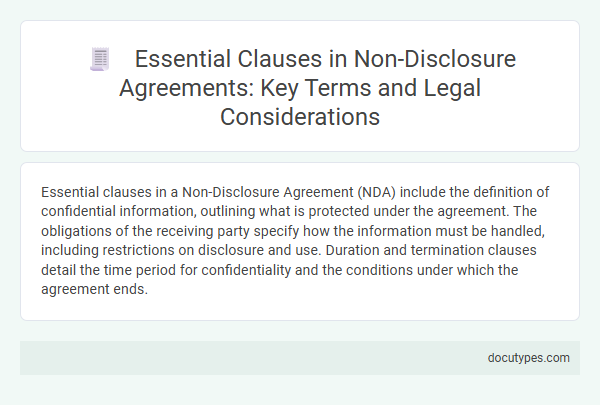Essential clauses in a Non-Disclosure Agreement (NDA) include the definition of confidential information, outlining what is protected under the agreement. The obligations of the receiving party specify how the information must be handled, including restrictions on disclosure and use. Duration and termination clauses detail the time period for confidentiality and the conditions under which the agreement ends.
Introduction to Non-Disclosure Agreements (NDAs)
Non-Disclosure Agreements (NDAs) are legal contracts designed to protect sensitive information shared between parties. They establish a confidential relationship, ensuring that the disclosed information is not shared with unauthorized individuals or entities.
Important clauses in NDAs include definitions of confidential information, obligations of the receiving party, and the duration of confidentiality. Your agreement should clearly outline these to safeguard proprietary data and maintain trust between involved parties.
Purpose and Scope of NDAs
The Purpose clause in a Non-Disclosure Agreement (NDA) clearly defines the intent behind sharing confidential information, ensuring all parties understand why the data is protected. This clause sets boundaries to prevent misuse or unauthorized disclosure of sensitive details.
The Scope clause specifies the types of information covered under the NDA, detailing what is considered confidential. It outlines the limits of disclosure and the duration for which confidentiality must be maintained, protecting Your interests effectively.
Definition of Confidential Information
A Non-Disclosure Agreement (NDA) is a legal contract that protects sensitive information shared between parties. It restricts the recipient from disclosing or using the confidential data for unauthorized purposes.
The Definition of Confidential Information clause is crucial in an NDA as it precisely outlines what information is protected under the agreement. This clause can include business plans, trade secrets, financial data, and proprietary technology, ensuring all parties understand which information must remain private. Clear definitions help prevent disputes and provide a solid legal foundation for confidentiality obligations.
Obligations of the Receiving Party
The obligations of the receiving party are crucial in a Non-Disclosure Agreement to protect confidential information. These clauses define what you must do to safeguard sensitive data shared during the agreement.
- Confidentiality Duty - The receiving party must keep all disclosed information strictly confidential and not share it with unauthorized individuals.
- Use Limitation - The receiving party is required to use the confidential information exclusively for the agreed purpose stated in the NDA.
- Return or Destruction - Upon termination, the receiving party must return or destroy all confidential materials as specified in the agreement.
Exclusions from Confidentiality
Exclusions from confidentiality define specific information that is not protected under a Non-Disclosure Agreement (NDA). These clauses typically include information already known to the receiving party, publicly available data, and details independently developed without using confidential information. Understanding these exceptions helps you differentiate between protected and non-protected information, ensuring clarity and legal security.
Duration and Term of Confidentiality
The duration and term of confidentiality are critical clauses in a Non-Disclosure Agreement (NDA) that define how long the parties must maintain secrecy. These clauses ensure that sensitive information remains protected throughout a specified timeframe.
- Duration of Agreement - Specifies the time period during which the NDA is legally binding and enforceable.
- Term of Confidentiality - Defines how long the receiving party must keep the disclosed information confidential, often extending beyond the duration of the agreement.
- Renewal and Extension - Outlines conditions for automatically renewing or extending the confidentiality obligations if necessary.
Clearly defining duration and confidentiality terms is essential for effective protection of trade secrets and proprietary information.
Permitted Disclosures and Exceptions
| Clause | Description | Importance |
|---|---|---|
| Permitted Disclosures | This clause defines specific situations where confidential information may be shared without breaching the agreement. Common instances include disclosures to affiliates, legal advisors, or as required by law. | Ensures clarity on when You can lawfully share information, limiting disputes and protecting sensitive data. |
| Exceptions | Outlines types of information not covered by the agreement, such as data already publicly known, independently developed, or obtained from third parties without restriction. | Prevents the overextension of confidentiality obligations and clarifies which information is free from restrictions. |
Remedies for Breach of NDA
Remedies for breach of NDA are critical clauses that outline the consequences if confidential information is disclosed without authorization. These clauses typically include injunctive relief, monetary damages, and specific performance to protect the disclosing party's interests. Your agreement should clearly specify the available legal remedies to enforce confidentiality and mitigate potential harm.
Governing Law and Jurisdiction
The Governing Law and Jurisdiction clauses in a Non-Disclosure Agreement (NDA) specify the legal framework and location where disputes will be resolved. These clauses ensure clarity and reduce uncertainty in enforcing the agreement.
- Governing Law Clause - Defines which state or country's laws will apply to interpret and enforce the NDA.
- Jurisdiction Clause - Specifies the courts that have authority to hear any legal disputes arising from the NDA.
- Dispute Resolution Location - Establishes the agreed venue for resolving conflicts to streamline legal proceedings.
What Are the Essential Clauses in a Non-Disclosure Agreement? Infographic

